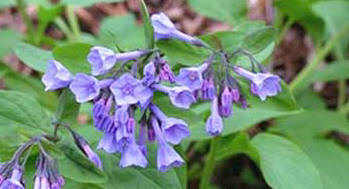
Many gardeners make the mistake of trying to grow sun-loving shrubs and flowers in garden areas better suited for shade-loving plants. This dilemma often brings with it disappointment, which lasts, for most gardeners, only until they discover that
there are many alluring flowers and soft foliage plants that can transform shady gardens into cool, inviting spots that bring enjoyment during the long, hot days of summer.
When growing shade-loving plants, it is important to understand that not all shade is the same.
Deep shade is an all day shade where no direct sun reaches the ground. Fewer plants thrive in this type of shade than in any other.
Part or half shade means shade for part of the day with direct sunlight during the other part. Many sun-loving plants bloom well in half shade as long as they receive 4 to 6 hours of direct sun each day. Morning sun and afternoon shade is better for
shade plants than morning shade and afternoon sun.
Light or filtered shade occurs under a tree canopy of open-branched trees where spots of sunshine filter to the ground in a constantly shifting play of shadows. Many plants prosper in this type of shade.
Open shade occurs on the north side of a building where no direct sunlight falls, but where light may be reflected to the ground from surrounding walls.
Surrounded by a deciduous woodland garden, as I am privileged to be, affords me the seasonal assurance of enough shade to be effectively shielded from the intense heat of summer, at which time we enjoy cooler temperatures than neighbors in non-wooded
areas. With the luxury of tall oaks and poplars and an under story layer of dogwood and redbud, we can garden with a degree of comfort in the dappled shade.
It was mid-winter when we purchased our property many years ago, and we had not realized how shady it would become once the trees leafed out. And it wasnít until a group of landscape design students from Temple University agreed to design our garden,
as a class project, that we became familiar with shade plants suitable to our woodland setting.
The result today is a cool, luxuriant setting among various woody shrubs beneath the trees. Among them are rhododendrons, azaleas, skimmias, leucothoe, mugo pines, boxwood, viburnums, pieris, hydrangeas, and mahonias.
There is also a multitude of shade and shade tolerant perennials throughout. The first to appear are snowdrops pushing their way up through the snow in late winter; then come hellebores with their lustrous evergreen leaves and waxy, cup-shaped
flowers followed by a myriad of attention-seeking flowering bulbs busily competing to out bloom one another.
|

Mertensia virginica (Virginia Blubells)
|
The appearance of the first crocus assures us that our naturalized daffodils and Virginia bluebells are not far behind; and after their dramatic appearance, along come windflowers and grape hyacinths and delicate scilla among the rhododendron,
interspersed with trillium and cyclamen. When the bleeding hearts start "showing their stuff," may apples "do their thing" as do jack-in-the-pulpits.
But unfortunately, we have some disappointments this year. Visiting deer, in spite of our efforts to change the appetites of these handsome creatures, have again nipped our valiant day lilies. The deer have also discovered our hosta beds and have
taken to our prized specimens like a child to candy. Refusing to succumb to their voracious appetites, we shall continue to plant hostas, as we endeavor to alter the attraction to them with a variety of suggested cures.
The cascading waterfall at our small pond helps to produce enough humidity to delight us with a spectacular show in mid-May of primroses in the adjoining rock garden.
And just about the time the pulmonarias begin to put forth their mottled leaves, we hurry to a secret place, next to a very large rock to rediscover our seasonal treat: a grouping of showy orchid, O. spectabilis. We discovered these tiny native
orchids more than 20 years ago and have enjoyed them ever since. Unfortunately, a lady slipper orchid plant discovered about the same time fell victim to an earth-moving contractorís heavy equipment and disappeared.
Shade gardening is a "cool" pastime with seemingly never-ending rewards of unusual flowers and foliage. If you don't already have trees, start by planting one and add a few woody shrubs nearby and get involved in this "shady" pastime. Donít worry.
Itís okay.
Read other articles on gardening techniques
Read other articles by George Geralis